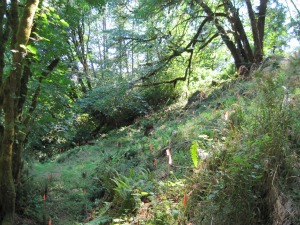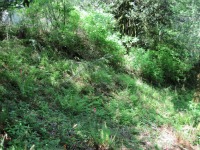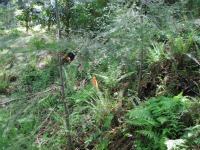Storm Damage recovery from what nature does
to your forestry garden

Storm damage and the recovery from is something that you may be interested in if nature has delivered a storm that did some damage to your forestry garden.
You have gone to the trouble and expense to convert your country acreage into a forestry garden and then over night a lot of it is destroyed.
What to do is the question now?
I have some areas that are now a reproductive forest and have the young trees that are about 8 to 20 feet tall.
These are from 1 1/2inch to 5inch in diameter.
These are real susceptible to storm damage.
They haven't gotten the anchor roots down to withstand the rigors of the wind and snow.
When they get more mature they can withstand a lot but not now.
We have had a lot of rain this winter and the ground is saturated with moisture.
This is a large factor to what the trees can withstand.

To top this off we got a very wet snow.
Overnight we got 6inch of this stuff.
The evergreens are a prime candidate for storm damage when this happens.
They have the boughs that collect the snow and being as how it is wet it sticks on the boughs.
If the limb doesn't break off, which it normally doesn't then the weight will keep on multiplying until the tree will be forced over onto the ground.
Steps to take to secure the trees upright
- Pull the tree up to upright position
- Drive stake in ground
- Secure with rope

How you will be able to pull the tree back to an upright position will depend on the terrain.
Do you have a road in the area so you can use your crawler winch to winch it up?
If not you will have to use a come-a-long and manually winch it up.
If you are going to use a tree that is close by for the anchor I recommend that you make sure you do not damage the bark on this tree.
I use a cloth strap to wrap the tree and thus eliminate the possibility to damage to the tree.
For stakes I take some 1x4 material and cut at about 3ft or so.
Then I run it through the saw and put a point on the end.
This makes for easier driving and if the ground is hard it will eliminate the possibility of splitting the stake.
Now that you have the stake made position it back from the tree opposite the way the tree was laying on the ground.
Do this approximately six feet or so from the base of the tree.
Drive the stake into the ground at a backward angle of 30 or so degrees.
You have the tree back in an upright position and have the stake driven into the ground so now it is time to secure the tree to the stake.
Take some small rope that will withstand the weather conditions and tie a loose knot in the rope around the tree.
Do this where you can reach, 7ft or so up the tree.
Take the other end and tie it to the stake.
After I have the tree secured I like to take a shovel and place some fill dirt around the trunk of the tree.
Tamping the loose dirt around the roots.
This will keep the air from getting to the roots and killing them.
I build up enough of this dirt to make the base secure.
If the ground is moist, which it will be in this case, then the survival rate from the storm damage of your trees is pretty good.
You do not have a lot to lose except for your time and effort.
Your young tree will die if you don't stand it back up.
So isn't it worth the time and effort to try and save this tree from the storm damage?
A tree that you nurtured all the way from a small seedling to what it is now.
You do need to keep tabs on the trees and make sure that the rope that you used isn't cutting into the tree.
When the tree diameter gets large enough to start to get tight it would be a good time to remove the rope and see if the tree will stand by itself.
If it still needs help then you can tie a loose knot and secure it again.
If you come across some trees that have the roots exposed I don't think that they can be salvaged.
I normally just go ahead and cut them up for firewood.
I think of this as the pre-commercial thinning.
This is another topic that will be covered in another page.
So now that you have the storm damage done all you need to do now is wait and observe to see how successful you were in your efforts to try and salvage your young trees.
Hopefully if you followed these tips you will have good results.
From
From storm damage to forestry gardening tips
Click here to read our privacy policy: Privacy Policy





